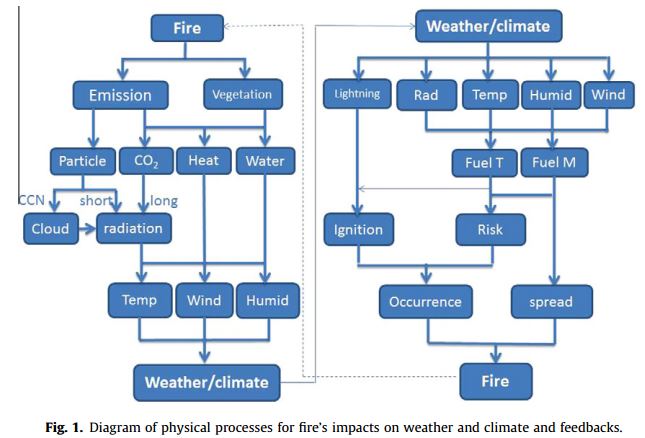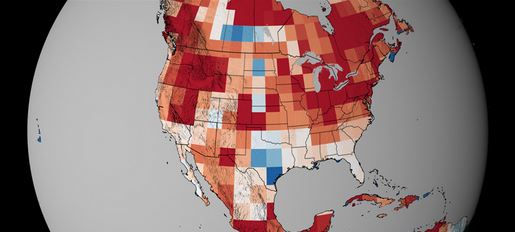Federal employees working for the United States Forest Service and the citizens of the United States have published the results of research done on behalf of the taxpayers, titled Climate Change and Wildfire. If you want to read it you will have to pay $35.95 to the for-profit Elsevier corporation headquartered in the Netherlands that published the paper. It was written by research meteorologists Yongqiang Liu and Scott Goodrick from the Forest Service’s Southern Research Station (SRS) and Warren Heilman from the Northern Research Station. The concept of Open Access to taxpayer-funded research still has a long way to go in the U.S. Forest Service.
Below are some highlights of the research, according to the USDA Forest Service’s Southern Research Station. We will have to take their word for it. The agency suggests that “for the full text of the article” go to the Elsevier web site, where you have to pay $35.95.
****
(UPDATE at 11:44 a.m. MST, February 24, 2014)
After we reached out to her and left a message, we received a phone call today from Zoë Hoyle, the author of the press release about the research that was issued May 20, 2013. She said the link to the full text of the article which directed web site visitors to the pay wall was an error. She said the usual practice of USFS researchers is to place their results on http://www.treesearch.fs.fed.us/ where they can be read at no charge, but that still has not taken place. Ms. Hoyle said, however, that the paper should be on treesearch by the end of this week.
In the meantime, one of our readers, Liz H., used Google Scholar to find a copy of it at firescience.gov. Thanks Liz.
And thanks go out also to Ms. Hoyle for correcting the oversight. We are pleased to hear that the usual practice of the USFS is to publish their research on treesearch, an open access format on the internet.
****
(UPDATE at 1:54 p.m. MST, February 24, 2014)
Ms. Hoyle contacted us again to let us know that the USFS was able to expedite the placement of the research paper on treesearch, where it can now be viewed without having to pay the company from the Netherlands $35.95.
Here is one of the illustrations from the paper, about the interactions between the climate and fire.
Below is an excerpt from the May 20, 2013 USFS news release about the research.
****
“While research has historically focused on fire-weather interactions, there is increasing attention paid to fire-climate interactions,” says Liu, lead author and team leader with the SRS Center for Forest Disturbance Science. “Weather, the day-to-day state of the atmosphere in a region, influences individual fires within a fire season. In contrast, when we talk about fire climate, we’re looking at the statistics of weather over a certain period. Fire climate sets atmospheric conditions for fire activity in longer time frames and larger geographic scales.”
Wildfires impact atmospheric conditions through emissions of gases, particles, water, and heat. Some of the article focuses on radiative forcing from fire emissions. Radiative forcing refers to the change in net (down minus up) irradiance (solar plus longwave) at the tropopause, the top of the troposphere where most weather takes place.
Smoke particles can generate radiative forcing mainly through scattering and absorbing solar radiation (direct radiative forcing), and modifying the cloud droplet concentrations and lifetime, and hence the cloud radiative properties (indirect radiative forcing). The change in radiation can cause further changes in global temperatures and precipitation.
“Wildfire emissions can have remarkable impacts on radiative forcing,” says Liu.
“During fire events or burning seasons, smoke particles reduce overall solar radiation absorbed by the atmosphere at local and regional levels. At the global scale, fire emissions of carbon dioxide contribute substantially to the global greenhouse effect.”
Other major findings covered in the synthesis include:
- The radiative forcing of smoke particles can generate significant regional climate effects, leading to lower temperatures at the ground surface.
- Smoke particles mostly suppress cloud formation and precipitation. Fire events could lead to more droughts.
- Black carbon, essentially the fine particles of carbon that color smoke, plays different roles in affecting climate. In the middle and lower atmosphere, its presence could lead to a more stable atmosphere. Black carbon plays a special role in the snow-climate feedback loop, accelerating snow melting.
Land surface changes may be triggered that also play into future effects. “Wildfire is a disturbance of ecosystems,” says Liu. “Besides the atmospheric impacts, wildfires also modify terrestrial ecosystem services such as carbon sequestration, soil fertility, grazing value, biodiversity, and tourism. The effects can in turn trigger land use changes that in turn affect the atmosphere.”
The article concludes by outlining issues that lead to uncertainties in understanding fire-climate interactions and the future research needed to address them.
Full text of the article: [note from Bill. We deleted the link to the for-profit web site with the pay wall]









